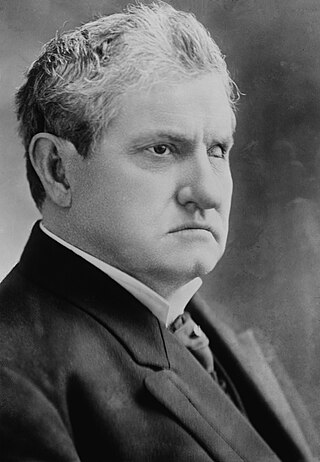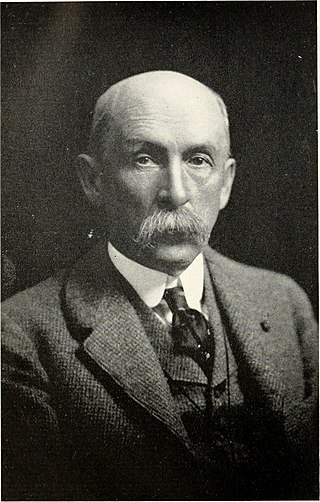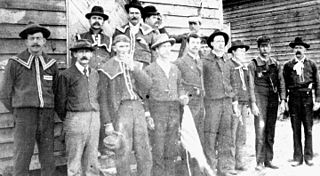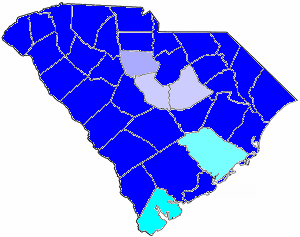Related Research Articles

Benjamin Ryan Tillman was a politician of the Democratic Party who served as governor of South Carolina from 1890 to 1894, and as a United States Senator from 1895 until his death in 1918. A white supremacist who opposed civil rights for black Americans, Tillman led a paramilitary group of Red Shirts during South Carolina's violent 1876 election. On the floor of the U.S. Senate, he defended lynching, and frequently ridiculed black Americans in his speeches, boasting of having helped kill them during that campaign.

Wade Hampton III was an American military officer who joined the Confederate States of America in rebellion against the United States during the American Civil War. He later had a career as a South Carolina politician. Hampton came from a wealthy planter family. Shortly before the war, he was both one of the largest enslavers in the Southeastern United States and a state legislator. During the American Civil War, he joined the Confederate cavalry, where he was a lieutenant general.

Daniel Henry Chamberlain was an American planter, lawyer, author and the 76th Governor of South Carolina from 1874 until 1876 or 1877. The federal government withdrew troops from the state and ended Reconstruction that year. Chamberlain was the last Republican governor of South Carolina until James B. Edwards was elected in 1974.
South Carolina was one of the Thirteen Colonies that first formed the United States. European exploration of the area began in April 1540 with the Hernando de Soto expedition, which unwittingly introduced diseases that decimated the local Native American population. In 1663, the English Crown granted land to eight proprietors of what became the colony. The first settlers came to the Province of Carolina at the port of Charleston in 1670. They were mostly wealthy planters and their slaves coming from the English Caribbean colony of Barbados. They started to develop their commodity crops of sugar and cotton. The Province of Carolina was split into North and South Carolina in 1712. Pushing back the Native Americans in the Yamasee War (1715–1717), colonists next overthrew the proprietors' rule in the Revolution of 1719, seeking more direct representation. In 1719, South Carolina became a crown colony.

Coleman Livingston Blease was an American politician of the Democratic Party who served as the 89th governor of South Carolina from 1911 to 1915, and as a United States senator from 1925 to 1931. Blease was the political heir of Benjamin Tillman. He led a political revolution in South Carolina by building a political base of white textile mill workers from the state's upcountry region. He was notorious for playing on the prejudices of Poor Whites to gain their votes and was an unrepentant white supremacist. Ultimately, despite his political strength, Blease failed to pass any significant legislation while governor.

The Hamburg Massacre was a riot in the United States town of Hamburg, South Carolina, in July 1876, leading up to the last election season of the Reconstruction Era. It was the first of a series of civil disturbances planned and carried out by white Democrats in the majority-black Republican Edgefield District, with the goal of suppressing black Americans' civil rights and voting rights and disrupting Republican meetings, through actual and threatened violence.
More than 1,500 African American officeholders served during the Reconstruction era (1865–1877) and in the years after Reconstruction before white supremacy, disenfranchisement, and the Democratic Party fully reasserted control in Southern states. Historian Canter Brown Jr. noted that in some states, such as Florida, the highest number of African Americans were elected or appointed to offices after the end of Reconstruction in 1877. The following is a partial list of notable African American officeholders from the end of the Civil War until before 1900. Dates listed are the year that a term states or the range of years served if multiple terms.

Thomas Ezekiel Miller was an American educator, lawyer and politician. After being elected as a state legislator in South Carolina, he was one of only five African Americans elected to Congress from the South in the Jim Crow era of the last decade of the nineteenth century, as disfranchisement reduced black voting. After that, no African Americans were elected from the South until 1972.

The 1876 South Carolina gubernatorial election was held on November 7, 1876, to select the governor of the state of South Carolina. The election campaign was a referendum on the Radical Republican-led state government and their Reconstruction policies. Opponents disputed the challenger Wade Hampton III's victory, gained by a margin of little more than 1100 votes statewide. But he took office in April 1877, after President Hayes withdrew federal troops as a result of a national Democratic compromise, and the incumbent Daniel Henry Chamberlain left the state.

The 1878 South Carolina gubernatorial election was held on November 5, 1878 to select the governor of South Carolina. Wade Hampton III was renominated by the Democrats and ran against no organized opposition in the general election to win reelection for a second two-year term.

The 1870 South Carolina gubernatorial election was held on October 19th, 1870 to select the governor of the state of South Carolina. Governor Robert Kingston Scott easily won reelection based entirely on the strength of the black vote in the state. The election was significant because white conservatives of the state claimed it showed that political harmony between the white and black races was impossible and only through a straightout Democratic attempt would they be able to regain control of state government.

The Red Shirts or Redshirts of the Southern United States were white supremacist paramilitary terrorist groups that were active in the late 19th century in the last years of, and after the end of, the Reconstruction era of the United States. Red Shirt groups originated in Mississippi in 1875, when anti-Reconstruction private terror units adopted red shirts to make themselves more visible and threatening to Southern Republicans, both whites and freedmen. Similar groups in the Carolinas also adopted red shirts.
The South Carolina civil disturbances of 1876 were a series of race riots and civil unrest related to the Democratic Party's political campaign to take back control from Republicans of the state legislature and governor's office through their paramilitary Red Shirts division. Part of their plan was to disrupt Republican political activity and suppress black voting, particularly in counties where populations of whites and blacks were close to equal. Former Confederate general Martin W. Gary's "Plan of the Campaign of 1876" gives the details of planned actions to accomplish this.

The 1882 South Carolina gubernatorial election was held on November 7, 1882 to select the governor of the state of South Carolina. Hugh Smith Thompson was nominated by the Democrats and ran against J. Hendrix McLane, a Greenback-Labor candidate. Thompson easily won the general election and became the 81st governor of South Carolina.

The 1890 South Carolina gubernatorial election was held on Tuesday November 4, to elect the governor of South Carolina. Ben Tillman was nominated by the Democrats and easily won the general election against A.C. Haskell to become the 84th governor of South Carolina.
Alexander Cheves Haskell was a Colonel in the Confederate Army during the American Civil War and a Democratic politician in postbellum South Carolina.

The 1892 South Carolina gubernatorial election was held on November 8, 1892 to select the governor of the state of South Carolina. Governor Ben Tillman was renominated by the Democrats and was elected in the general election to a second two-year term.

The 1896 South Carolina gubernatorial election was held on November 3, 1896 to select the governor of the state of South Carolina. William Haselden Ellerbe won the Democratic primary and easily won the general election to become the 86th governor of South Carolina.
The 1912 South Carolina gubernatorial election was held on November 5, 1912, to select the governor of the state of South Carolina. Governor Coleman Livingston Blease won the Democratic primary. As South Carolina was a utterly dominated by the Democratic Party, he faced no significant opposition in the general election.

This history of the University of South Carolina began in the 18th century when intersectional differences arose between the Lowcountry and the Upstate. It was conceived that a state supported college located in the center of the state at Columbia, South Carolina, would foster friendships between those of both regions thus allowing the state to present a united front to the nation when threatened with issues jeopardizing the South Carolina way of life. The University of South Carolina's history can be described in four distinct phases: a firebrand college (1801–1862), constant reorganization (1865–1891), college to university (1891–1944) and the state's university (1944–present).
References
- 1 2 3 4 Simmons, William J., and Henry McNeal Turner. Men of Mark: Eminent, Progressive and Rising. GM Rewell & Company, 1887. pages 162-164
- 1 2 Smith Jr, J. Clay. Emancipation: The Making of the Black Lawyer, 1844-1944. University of Pennsylvania Press, 1999. p 223
- ↑ Doings of the Race. New York Globe (New York, New York), February 16, 1884, page 2
- ↑ [No Headline], Washington Bee (Washington, DC), June 20, 1885, page 3
- ↑ To Vote for a Democrat, Pittsburgh Dispatch (Pittsburgh, Pennsylvania), October 17, 1890, page 1, accessed August 30, 2016
- ↑ Prof. Morris Honored, State (Columbia, South Carolina), March 29, 1893, page 5
- ↑ Negro Committed to Jail William Johnson Accused of Stabbing Viola Morris, State (Columbia, South Carolina), Friday, November 12, 1909, Issue: 6914 Page: 5
- ↑ Negro Educator Dies in Columbia, State (Columbia, South Carolina), Sunday, September 14, 1913 Issue: 7996 Section: Part I Page: 3